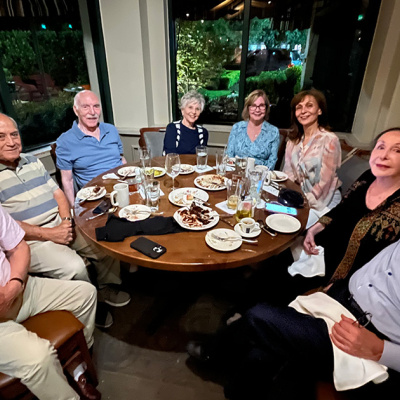Way Out West

We all know Texas is big. We often rumble around in the part we live in (if we’re lucky), and we kind of know that it’s big, but it’s probably only a small part of this vast expanse called Texas. For a real sense of how big the state is, west of the Pecos really delivers. As a start, it is over 500 miles from Houston to the heart of the Trans-Pecos. When the Texas Exes offered a tour of West Texas, they had to think big, but that comes naturally. This is Texas. This past May, the Flying Longhorns landed in Midland and motored to the county seats and historical forts that dot this vast landscape. It was a tour of the far reaches of this place so many UT alumni call home.
Most mental images we have of West Texas are of a wide, flat, dry, scrubby, mostly empty landscape. That’s far from the truth—about as far as Houston is from Marfa. West Texas is booming with life, oddities, historical places, mountains, and valleys. Our tour started off with a night in Pecos, made famous by Judge Roy Bean as the “law west of the Pecos,” and home to the best cantaloupe anywhere. Any visit to West Texas includes a visit to the many World War II bases where they taught pilots to fly in the abundant sunshine and clear skies. Marfa, where George Patton was once stationed, is famous for those mysterious lights and is now a rather peculiar town full of artists, ranchers, hipsters, and jet-setting New York art types.

To add to the sense of vastness, a visit to UT’s McDonald Observatory in Fort Davis had us all craning our necks up to the night sky. Sitting on top of two of the taller peaks in Texas, in the middle of a dark zone to avoid light pollution, the Observatory sports two telescopes ranked in the top 10 most powerful in the world. Our little group joined several hundred others for a Star Party, a kind of guided tour of the universe through five telescopes set up around the property, followed the next morning by a private guided tour of the massive scopes. Talk about big!
It just got better. Down we went through Terlingua—a place populated with people who are a little crazy and proud of it—to Big Bend National Park for two days in the Chisos Basin. The Park is separated from Mexico by the Rio Not-So-Grande (it happens when you get less than an inch of rain this year) and is located in Brewster County, the largest county in Texas. How big is Brewster County? Almost 6,200 square miles—more than 600 square miles larger than the state of Connecticut.
For good measure, our trusty tour director, Byron Cade of Heritage Tours, threw in a total eclipse of the moon while we were in the Chisos Basin. The moon turned deep red to put on a great show for us watching down below. Call it a Texas bonus!


West Texas teaches you how big Texas is and why it is this “big wonderful thing,” to quote Georgia O’Keefe. The history of this area is relatively young, only about 150 years old; but it is full of life and already has a story that is bursting at the seams. The McDonald Observatory was an experience in itself, as was Big Bend. Even if you take those away, the little towns that fight and survive out here—Marfa, Fort Davis, Fort Stockton, Terlingua, Monahans, Marathon, Pecos—are worth the trip all by themselves. You can see the world, but if you don’t see Texas, well, you need to think bigger.
Words and pictures by Pat Cook, BA ’73, Life Member






